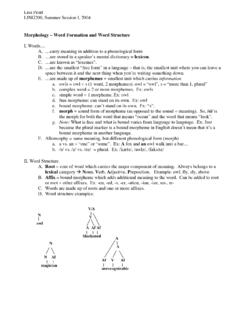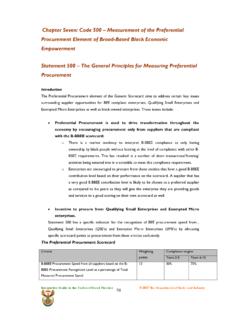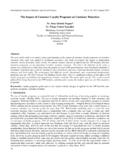Transcription of Econ 20B- Additional Problem Set 4
1 Econ 20B- Additional Problem Set 4. I. MULTIPLE CHOICES. Choose the one alternative that best completes the statement to answer the question. 1. Institutions in the economy that help to match one person's saving with another person's investment are collectively called the a. Federal Reserve system. b. banking system. c. monetary system. d. financial system. ANS: D. 2. Which of the following is not correct? a. When a country saves more, it has more capital. b. A supplier of loanable funds borrows money. c. The interest rate adjusts to balance the quantity supplied of and the quantity demanded of loanable funds. d. If Mary buys equipment for her factory, Mary is engaging in capital investment. ANS: B. 3. A bond is a a.
2 Financial intermediary. b. certificate of indebtedness. c. certificate of partial ownership in an enterprise. d. None of the above is correct. ANS: B. 4. The length of time until a bond matures is called the a. perpetuity. b. term. c. maturity. d. intermediation. ANS: B. 5. A bond that never matures is known as a a. perpetuity. b. an intermediary bond. c. an indexed bond. d. a junk bond. ANS: A. 6. Stock represents a. a claim to a share of the profits of a firm. b. ownership in a firm. c. equity finance. d. All of the above are correct ANS: D. 7. Which of the following is not an important stock exchange in the United States? a. New York Stock Exchange b. American Stock Exchange c. Chicago Mercantile Exchange d.
3 NASDAQ. ANS: C. 8. Stock indexes are a. the average of a group of stock prices. b. the average of a group of stock yields. c. reports in the newspaper that report on the price of the stock and earnings of the corporation. d. measures of the risk relative to the profitability of corporations. ANS: A. 9. Which of the following are financial intermediaries? a. both banks and mutual funds b. banks but not mutual funds c. mutual funds but not banks d. neither banks or mutual funds ANS: A. 10. A mutual fund a. is a financial market where small firms mutually agree to sell stocks and bonds to raise funds. b. is funds set aside by local governments to lend to small firms who want to invest in projects that are mutually beneficial to the firm and community.
4 C. sells stocks and bonds on behalf of small and less known firms who would otherwise have to pay high interest to obtain credit. d. is an institution that sells shares to the public and uses the proceeds to buy a selection of various types of stocks, bonds, or both stocks and bonds. ANS: D. 11. Which of the following equations will always represent GDP in an open economy? a. S=I-G. b. I=Y-C+G. c. Y=C+I+G. d. Y = C + I + G + NX. ANS: D. 12. Which of the following equations represents national saving in a closed economy? a. Y - I - G - NX. b. Y-C-G. c. Y-I-C. d. G+C-Y. ANS: B. 13. In a closed economy, national saving equals a. investment. b. income minus the sum of consumption and government purchases. c.
5 Private saving plus public saving. d. All of the above are correct. ANS: D. 14. Suppose a closed economy had public saving of $3 trillion and private saving of $2 trillion. What is national saving and investment in this country? a. $5 trillion, $5 trillion b. $5 trillion, $2 trillion c. $1 trillion, $5 trillion d. $1 trillion, $2 trillion ANS: A. 15. In a closed economy, what does (T - G) represent? a. national saving b. investment c. private saving d. public saving ANS: D. 16. In a closed economy, what does (Y - T - C) represent? a. national saving b. government tax revenue c. public saving d. private saving ANS: D. 17. The country of Nemedia does not trade with any other country. Its GDP is $30 billion.
6 Its government purchases $5 billion worth of goods and services each year, collects $7 billion in taxes, and provides $3. billion in transfer payments to households. Private saving in Nemedia is $5 billion. What is consumption and investment in Nemedia? a. $18 billion and $5 billion b. $21 billion and $4 billion c. $13 billion and $7 billion d. There is not enough information to answer the question. ANS: B. 18. The source of the supply of loanable funds a. is saving and the source of demand for loanable funds is investment. b. is investment and the source of demand for loanable funds is saving. c. and the demand for loanable funds is saving. d. and the demand for loanable funds is investment. ANS: A. 19.
7 Other things the same, when the interest rate rises a. people would want to lend more, making the supply of loanable funds increase. b. people would want to lend less, making the supply of loanable funds decrease. c. people would want to lend more, making the quantity of loanable funds supplied increase. d. people would want to lend less, making the quantity of loanable funds supplied decrease. ANS: C. 20. If there is a surplus of loanable funds a. the quantity of loanable funds demanded is greater than the quantity of loanable funds supplied and the interest rate is above equilibrium. b. the quantity of loanable funds demanded is greater than the quantity of loanable funds supplied and the interest rate is below equilibrium.
8 C. the quantity of loanable funds supplied is greater than the quantity of loanable funds demanded and the interest rate is above equilibrium. d. the quantity of loanable funds supplied is greater than the quantity of loanable funds demanded and the interest rate is below equilibrium. ANS: C. 21. If there is surplus of loanable funds, then a. the supply for loanable funds shifts right and the demand shifts left. b. the supply for loanable funds shifts left and the demand shifts right. c. neither curve shifts, but the quantity of loanable funds supplied increases and the quantity demanded decreases as the interest rate rises to equilibrium. d. neither curve shifts, but the quantity of loanable funds supplied decreases and the quantity demanded increases as the interest rate falls to equilibrium.
9 ANS: D. 22. What would happen in the market for loanable funds if the government were to increase the tax on interest income? a. Interest rates would rise. b. Interest rates would be unaffected. c. Interest rates would fall. d. The effect on the interest rate is uncertain. ANS: A. 23. A budget surplus a. raises the interest rate and investment. b. reduces the interest rate and investment. c. raises the interest rate and reduces investment. d. reduces the interest rate and raises investment. ANS: D. 24. Crowding out occurs when investment declines because a. a budget deficit makes interest rates rise. b. a budget deficit makes interest rates fall. c. a budget surplus makes interest rates rise. d. a budget surplus makes interest rates fall.
10 ANS: A. II. CALCULATIONS AND EXPLANATIONS. Compute the numbers and provide explanations when necessary. 1. Suppose the market for loanable funds is in equilibrium. Given the numbers below, find public savings, private savings, and the demand for loanable funds (investment). GDP $ trillion Consumption Spending $ trillion Taxes Net of Transfers $ trillion Government Purchases $ trillion ANS: Public Savings: T- G = = Private Savings: Y- T C = National Savings: Public Savings + Private Savings = + Demand for loanable funds comes from Investment = National Savings = $ trillion 2. Suppose that in a closed economy GDP is equal to 11,000, taxes are equal to 2,500 Consumption equals 7,500 and Government purchases equal 2,000.












